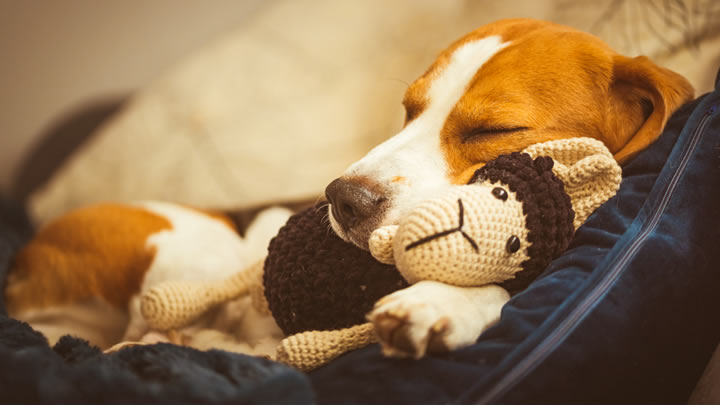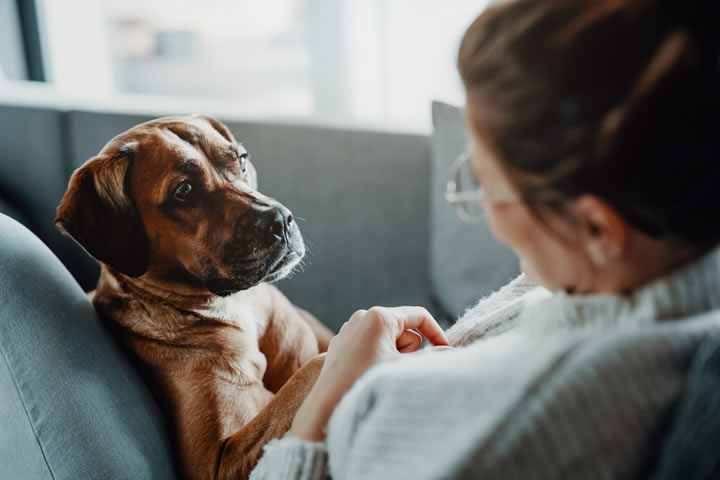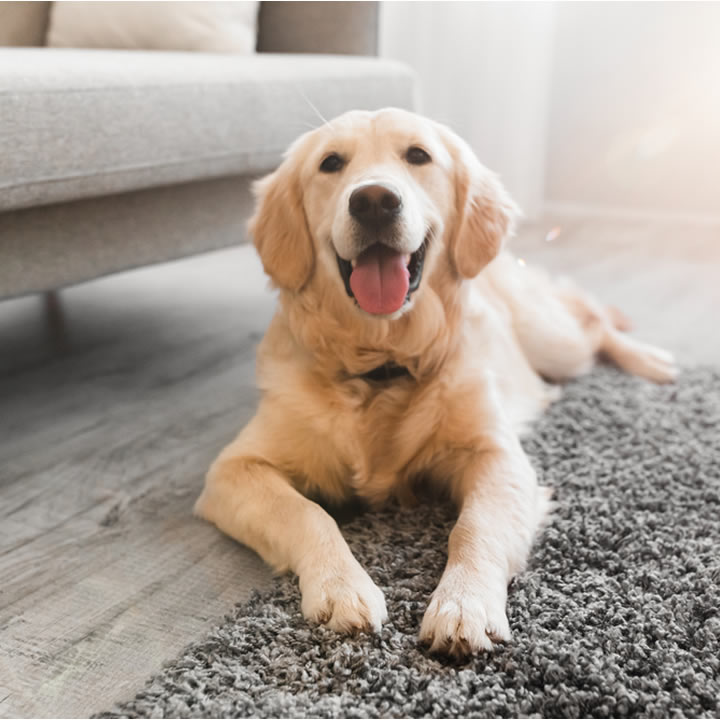Dogs react to stress during house shifting in different ways and take their own time to adjust to their new home. Consistently stick to its routine, bring its favorite items from its previous home, and ensure its safety to easing the process.
You can also stay with your dog for a few days, try anxiety relief products, or resort to professional help from a vet or trainer.
How to Get Your Dog Accustomed to a New Home?
Moving house can be fraught with stress, anxiety, and insecurity, even for your dog. If you’re wondering how to settle a dog into a new home, here’s a handy guide that includes all the tips you need to know to ease the transition.
How to Settle a Dog Into a New Home?
When you bring your dog with you to a new home, you may be anxious about how it will adjust to the change. You can feel truly content in your new accommodation once your dog has settled in too. But moving house with a dog is not an easy affair.
You may find your pet exhibiting behavioral issues that it didn’t have before. It may try to establish its territory by peeing everywhere, even hiding in its crate or under the bed or a chair.
Do dogs get anxiety when moving to a new home? Yes, some dogs may develop separation anxiety and start barking incessantly. Others, especially pups, may start throwing up due to the stress of rehoming.
Stress chewing on random things to deal with sudden change is also common. If your pet has eaten something that can be dangerous for its health and must vomit, here’s how to make your dog throw up.

You need to understand that each dog behaves differently during times of stress. If you’re wondering “How can I help my dog with anxiety in a new home?”, these tips are all you need:
Maintain a Routine
Stay consistent with your dog’s regular schedule for feeding, walks, exercise, training sessions, playtime, bedtime, and so on. This will help it feel that everything is normal and allow it to get used to the new house faster.
Stick to your pet’s usual meals and also feed it in the same location as you used to earlier. For example, if you normally feed your dog in the kitchen, continue feeding it in your new kitchen.
Bring Your Dog’s Favorites
It’s not only your dog’s routine that you should be consistent with. It’s also its favorite. If your dog is accustomed to certain things such as a doggy door, bed, or couch, set them up in the new house.
Also, avoid trying anything new at this time to prevent your dog from feeling overwhelmed and stressed. That includes meals, feeding locations, food, and water dishes, treats, toys, crates, collars, harnesses — you name it.
Bring them, too, from your old house or your dog’s foster home and keep them in the same places as they were previously. This will help your dog develop a sense of familiarity and control in your new home. Over time, that will make your pet feel secure and happy.
Ensure Your Dog’s Safety
One of the key concerns that your dog may have in a new house is safety and security. Its need for security may make it get frightened at any new sight, even the packing boxes or the change of scenery. This may cause it to run away and hide.
Allow your pet to get used to the packing supplies. Also, avoid cramping up the space where your dog usually hangs around with boxes and suitcases. Give it a dedicated space where it can feel safe and comfortable before, during, and after the transition.
If you have to take up the whole space in your old or new home for packing or unpacking, send your dog to a kennel or a friend’s house where it will feel comfortable and safe.
Also, ensure that it has proper identification along with your contact details. So if it ever gets lost during or after the house move, someone can safely return your pet to you.
Keep copies of veterinary records handy, too, to access them quickly if your dog gets hurt during the transition. Find out if there are any aggressive pets or strays in your new neighborhood or any other risks in the house or yard.
Stay With Your Dog for the First Few Days
During the first few days, your dog will feel uncomfortable and insecure as it tries to navigate its new home. During this time, it is advisable to stay with your dog at home as much as you can.
If left alone in the new house, your dog might start to feel more insecure and exhibit destructive behavior. Having you by its side will help your pet feel safe and secure.
If you cannot avoid leaving the house for more than an hour or so, try to take your dog with you or leave it with a family member or friend. After a few days, you can gradually increase the time for which you leave it alone, starting from 15 to 20 minutes a day and working up from there.
The day you have to leave your pet alone for more than a few hours, go on a long walk to tire your pet out before you go. This will make it more likely to rest most of the day and not indulge in any destructive behavior.
Use Anti-anxiety Aids
If your dog tends to feel anxious quickly, moving house can worsen its symptoms. For dogs with a high level of anxiety issues, speak to your vet about a month before your moving date and get some prescription anxiety medication.
You can also try other anti-anxiety aids, such as calming supplements and zen collars. Interestingly enough, there’s music online or on your favorite music app that is designed for relieving stress in animals.
CBD treats are another great option. They help take off the edge of your dog and help it feel calmer while adjusting to a new space.
Be Patient
Patience is key during the house shifting process. Just like you, your dog will take time to adjust to its new digs. Give it enough time to sniff around and check out its new home.
Or your dog may not be in the mood for exploring at all and may want to hide for a while. That, too, is fine and is a coping mechanism that your dog is using for the time being. Just make sure that it knows where its food and water dishes, doggy door, and pee pads are.
Your dog may display other changes in behavior for some time, including excessive eating or a lack of appetite, barking, chewing, etc. During this stressful period, you must stay patient and compassionate.
Understand that their new behaviors stem from stress and anxiety, and find ways to ease their transition.
Give Your Dog Lots of Love
Shower your pet with a lot of love and attention. A little extra love will help it feel more comfortable, secure, and at home in its new environment.
Get Help
Sometimes, the best thing you can do for your dog is to call for professional help. If your dog is not eating at all or displaying destructive behaviors such as chewing or biting despite your best efforts to help it, it may be a sign that it needs professional help.
Instead of scolding or punishing it, contact a veterinarian or a canine behaviorist.
Your dog’s difficult behavior is rooted in its insecurity and discomfort but can change with the right support. A trainer or vet will help you find the right route to ease your pet’s discomfort and make it feel more in control.
This will help it let go of its destructive or difficult habits and become a more confident, happy, and secure dog.
How Long Does It Take for a Dog to Get Used to a New Home?

How long does it take for a dog to adjust to a new home?
That depends on the dog’s personality. If your dog is more outgoing, social, and adventurous, it may need less time than other dogs to acclimate to its new home. Other dogs, especially reserved ones, may take longer to adjust.
On average, it takes around three days for your dog to get over the initial shock of moving house.
It will take another three weeks to a month for it to feel at home and settle in. If you follow a new routine in the new house, it may take your dog even longer to settle in, say, around three months.
How to settle a dog into a new home?
Helping your dog adjust to your new home is all about patience, time, and the right approaches to ease its stress and anxiety. Follow our tips above and your dog should be well on its way to becoming more confident, secure, and joyful in its new surroundings.

